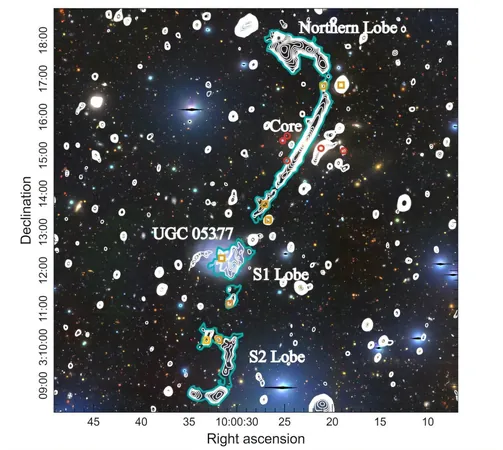
Breakthrough Discovery: Astronomers Find Massive New Radio Galaxy with MeerKAT!
2024-11-19
Author: Ming
Introduction
An extraordinary astronomical discovery has emerged from the depths of the universe, as an international team of scientists utilized the MeerKAT radio telescope to uncover a previously unreported giant radio galaxy (GRG) during their investigation of the Cosmological Evolution Survey (COSMOS). This groundbreaking finding was unveiled in a research paper published on November 11 on arXiv, creating excitement in the astronomical community.
What are Giant Radio Galaxies?
Giant radio galaxies are not your average celestial entities. Defined by their colossal size, GRGs stretch over 2.3 million light years in projected linear length and are typically found in low-density environments. These magnificent objects emit massive jets and lobes of synchrotron-plasma, making them vital to understanding the formation and evolution of radio sources in the cosmos.
The Role of the MeerKAT Radio Telescope
The MeerKAT radio telescope, located in South Africa, is renowned for its precision in studying GRGs at high frequencies (approximately 1.0 GHz). A team led by Kathleen Charlton from the University of Cape Town harnessed the power of this sophisticated instrument to explore known GRGs in the COSMOS field, as part of the MeerKAT International GHz Tiered Extragalactic Exploration (MIGHTEE) survey.
New Discovery: MGTC J100022.85+031520.4
The researchers conducted a detailed analysis of three GRGs using MIGHTEE L-band data alongside new observations from MeerKAT’s UHF band. One of the standout discoveries from this investigation was the identification of a new GRG, designated as MGTC J100022.85+031520.4. Unique and intriguing, this GRG is hosted by an elliptical galaxy known as SDSS J100022.85+031520, which has a redshift of around 0.1034.
Characteristics of MGTC J100022.85+031520.4
What sets MGTC J100022.85+031520.4 apart is its astonishing size, measuring about 4.2 million light years across, and an estimated mass of 93 trillion solar masses. The galaxy exhibits a powerful emission at 1,284 MHz, which boasts a total power of 597 ZW/Hz. Analysis of the data indicates that MGTC J100022.85+031520.4 has a dynamical age of approximately one billion years and the energy output of its jets reaches levels around one million QW!
Significance of the Findings
The researchers also discovered that MGTC J100022.85+031520.4 serves as the central galaxy and bright cluster galaxy (BCG) within the galaxy cluster WHL J100022.9+031521. Notably, this discovery places it among only about 4% of GRGs known to inhabit cluster environments. This significant positioning hints at interactions with the cosmic surroundings, providing further avenues for exploration.
Conclusion
In conclusion, the authors highlighted intriguing implications of their findings. The placement of MGTC J100022.85+031520.4 at the heart of its cluster, alongside the observed bent morphology in the top lobe, suggests it bears similarities to galaxies that harbor wide-angle-tail (WAT) radio sources. Generally, WAT radio sources are highly energetic and often found at galaxy cluster centers, where the pressure of the intracluster medium might distort the lobes into a defining C-shape.
As astronomers continue their quest to unlock the mysteries of the universe, discoveries like MGTC J100022.85+031520.4 remind us of the endless wonders that lie beyond our planet. Stay tuned for more updates as researchers delve deeper into the cosmos!


 Brasil (PT)
Brasil (PT)
 Canada (EN)
Canada (EN)
 Chile (ES)
Chile (ES)
 España (ES)
España (ES)
 France (FR)
France (FR)
 Hong Kong (EN)
Hong Kong (EN)
 Italia (IT)
Italia (IT)
 日本 (JA)
日本 (JA)
 Magyarország (HU)
Magyarország (HU)
 Norge (NO)
Norge (NO)
 Polska (PL)
Polska (PL)
 Schweiz (DE)
Schweiz (DE)
 Singapore (EN)
Singapore (EN)
 Sverige (SV)
Sverige (SV)
 Suomi (FI)
Suomi (FI)
 Türkiye (TR)
Türkiye (TR)